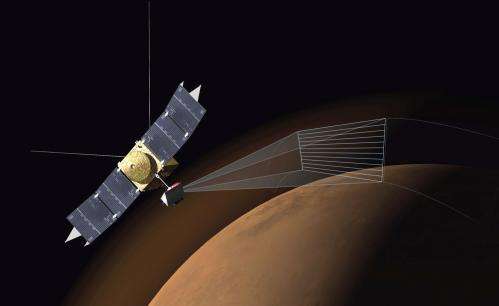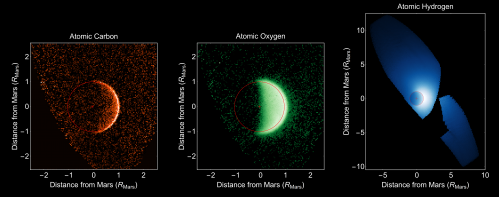Shortly after Mars comet, NASA's new red planet spacecraft officially starts mission

NASA's newest Mars spacecraft is "go" for at least a year—and potentially longer. After taking a time-out from commissioning to observe Comet Siding Spring whizz by the Red Planet in October, the Mars Atmosphere and Volatile Evolution (MAVEN) officially began its science mission Monday (Nov. 17). And so far things are going well.
"From the observations made both during the cruise to Mars and during the transition phase, we know that our instruments are working well," stated principal investigator Bruce Jakosky, who is with NASA's Goddard Space Flight Center in Maryland. "The spacecraft also is operating smoothly, with very few 'hiccups' so far. The science team is ready to go."
MAVEN arrived in orbit Sept. 16 after facing down and overcoming a potential long delay for its mission. NASA and other federal government departments were in shutdown while MAVEN was in final launch preparations, but the mission received a special waiver because it is capable of communicating with the rovers on Mars. Given the current relay spacecraft are aging, MAVEN could serve as the next-generation spacecraft if those ones fail.
But that's providing that MAVEN can last past the next year in terms of hardware and funding. Meanwhile, its primary science mission is better understanding how the atmosphere of Mars behaves today and how it has changed since the Red Planet was formed.
"The nine science instruments will observe the energy from the Sun that hits Mars, the response of the upper atmosphere and ionosphere, and the way that the interactions lead to loss of gas from the top of the atmosphere to space," Jakosky added.

"Our goal is to understand the processes by which escape to space occurs, and to learn enough to be able to extrapolate backwards in time and determine the total amount of gas lost to space over time. This will help us understand why the Martian climate changed over time, from an early warmer and wetter environment to the cold, dry planet we see today."
More information: mars.nasa.gov/news/whatsnew/in … ShowNews&NewsID=1752
Source: Universe Today




















